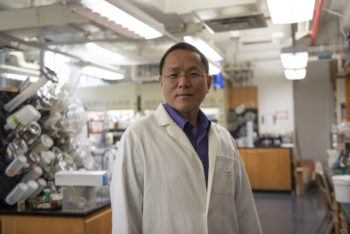Texas A&M Lab Continues Search For COVID-19 Drugs

Hospitalized until earlier this week at Walter Reed National Military Medical Center after testing positive for COVID-19, President Donald Trump was treated in part with remdesivir, an antiviral drug originally developed in response to the Ebola pandemic in 2014.
That recent development captured the attention of a Texas A&M University professor who was the first scientist to identify the Gilead Science-developed drug as a potential treatment option in January as news began to circulate about the novel coronavirus spreading through China. By the end of that month, A&M chemical biologist Wenshe Ray Liu quickly pivoted the focus of his lab from cancer research to finding a viable drug to treat COVID-19.
With family members living in Wuhan, the pandemic’s epicenter, Liu described the early days of watching the pandemic unfold as “like watching a horror movie.” Initially motivated to protect loved ones and spread the knowledge that remdesivir could be used to treat COVID-19 patients in China, Liu said he didn’t anticipate the scale and impact the virus would have on the world.
Nearly nine months after publishing his lab’s finding* on remdesivir, it was used to treat the president, in combination with an experimental “antibody cocktail.” While it hasn’t been approved by the Food and Drug Administration, remdesivir was authorized for emergency use to treat hospitalized patients.
Liu said remdesivir works by preventing the virus from replicating once inside human cells. When SARS-CoV-2 infects a cell, it releases a strand of RNA containing its genome. Remdesivir blocks the making of new copies of this RNA genome, he said.
While remdesivir can be effective, Liu said there still “are really no good existing medicines for COVID-19,” making the drug discovery process crucial.
Since that first month of 2020, Liu’s lab has been working to find a medicine to fight the virus. The team is made up of 20 members, half of which can be in the lab at any time due to safety restrictions.
“In March when the university was closed, a lot of students really worried about their health, and some of them hesitated to come back, but gradually they all wanted to come back because they wanted to contribute to this fight against COVID-19,” Liu said.
Liu’s work was one of eight interdisciplinary research projects that was awarded funding in July through Texas A&M’s X-Grants program.
The lab is working on two compounds that could be potent against COVID-19. They could block the virus’ replication process through targeting a critical enzyme and a virus membrane protein that binds to human receptors for infection. Pre-clinical studies will hopefully begin soon, Liu said.
“We have a lot of good leads right now,” Liu said. “I’m really confident in the next couple of years we’ll find a really good medicine which can effectively get rid of the virus.”
* This link is no longer active and has been removed.
Media contact: Caitlin Clark, caitlinclark@tamu.edu
Video by Mark Guerrero, Texas A&M University Division of Marketing & Communications



